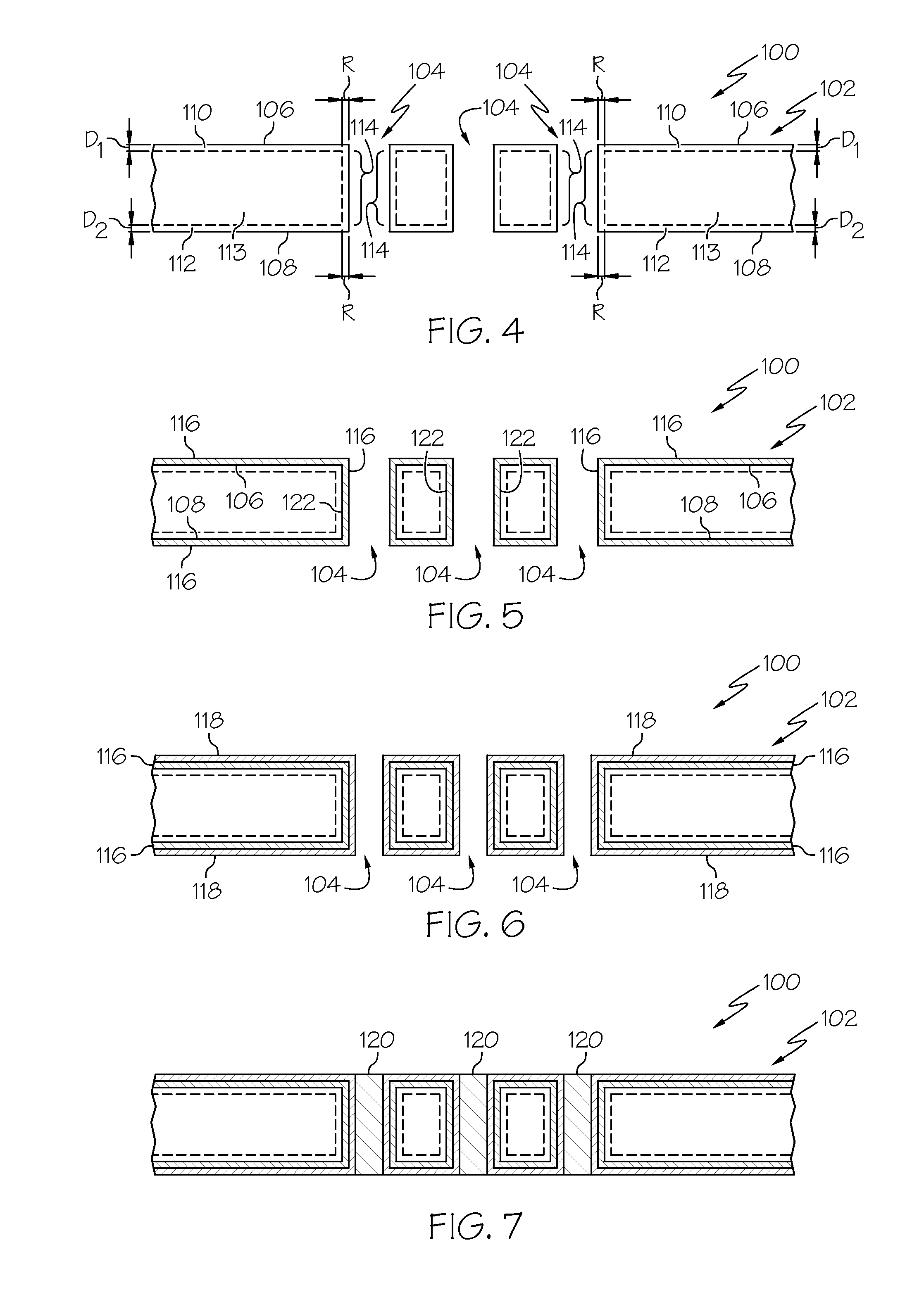Glass Interposer Panels And Methods For Making The Same
a technology of glass substrate core and glass core, which is applied in the direction of resistive material coating, cable/conductor manufacturing, metallic material coating process, etc., can solve the problems of limited input/output density, high thermal mismatch, and poor dimensional stability of organic interposer panels, and achieve greater strength of glass substrate cores
- Summary
- Abstract
- Description
- Claims
- Application Information
AI Technical Summary
Benefits of technology
Problems solved by technology
Method used
Image
Examples
example 1
[0057]Threes sets of 50 mm×50 mm glass interposer panels were formed from Gorilla™ alkali aluminosilicate glass. Each glass interposer panel had a thickness of 0.7 mm. In this example, a single through-via having a diameter of 1 mm was mechanically drilled at the center of each glass interposer panel, as indicated in FIG. 9. A first set of glass interposer panels were then mechanically tested to failure in as-drilled condition (i.e., without further processing) using ring-on-ring testing. The applied stress at failure (i.e., the failure stress) was recorded.
[0058]A second set of glass interposer panels were chemically etched in a solution of HF:HCl:20H2O for 15 minutes to remove defects from the surfaces of the glass interposer panels and from the through-vias. Each of the glass interposer panels in the second set of glass interposer panels was then mechanically tested to failure using ring-on-ring testing. The applied stress at failure for each glass interposer panel was recorded.
[...
example 2
[0061]Three sets of 50 mm×50 mm glass interposer panels were formed from Gorilla™ alkali aluminosilicate glass. Each glass interposer panel had a thickness of 0.7 mm. In this example, five through-vias were mechanically drilled in the glass interposer panel in a cross-configuration, as indicated in FIG. 10. Each through-via had a diameter of 1 mm and an edge-to-edge spacing of 300 microns. A first set of glass interposer panels was mechanically tested to failure in as-drilled condition (i.e., without further processing) using ring-on-ring testing. The applied stress at failure (i.e., the failure stress) was recorded.
[0062]A second set of glass interposer panels were chemically etched in a solution of HF:HCl:20H2O for 15 minutes to remove defects from the surfaces of the glass interposer panels and from the through-vias, as described above. Each of the glass interposer panels in the second set of glass interposer panels was mechanically tested to failure using ring-on-ring testing. T...
example 3
[0065]Threes sets of 50 mm×50 mm glass interposer panels were formed from Gorilla™ alkali aluminosilicate glass. Each glass interposer panel had a thickness of 0.7 mm. In this example, a single through-via having a diameter of 1 mm was laser drilled at the center of each glass interposer panel using a femtosecond laser trepanning technique. A first set of glass interposer panels were then mechanically tested to failure in as-drilled condition (i.e., without further processing) using ring-on-ring testing. The applied stress at failure (i.e., the failure stress) was recorded.
[0066]A second set of glass interposer panels were chemically etched in a solution of HF:HCl:20H2O for 15 minutes to remove defects from the surfaces of the glass interposer panels and from the through-vias. Each of the glass interposer panels in the second set of glass interposer panels was then mechanically tested to failure using ring-on-ring testing. The applied stress at failure for each glass interposer pane...
PUM
| Property | Measurement | Unit |
|---|---|---|
| radial thickness | aaaaa | aaaaa |
| compressive stress | aaaaa | aaaaa |
| thickness | aaaaa | aaaaa |
Abstract
Description
Claims
Application Information
 Login to View More
Login to View More - R&D
- Intellectual Property
- Life Sciences
- Materials
- Tech Scout
- Unparalleled Data Quality
- Higher Quality Content
- 60% Fewer Hallucinations
Browse by: Latest US Patents, China's latest patents, Technical Efficacy Thesaurus, Application Domain, Technology Topic, Popular Technical Reports.
© 2025 PatSnap. All rights reserved.Legal|Privacy policy|Modern Slavery Act Transparency Statement|Sitemap|About US| Contact US: help@patsnap.com



